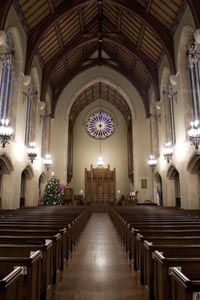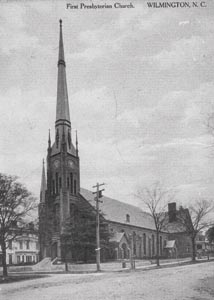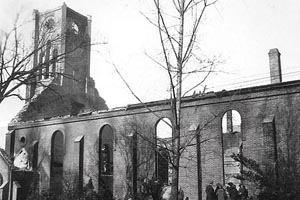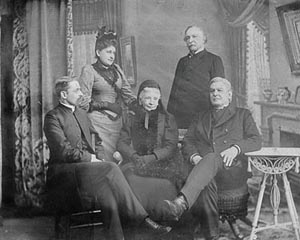Historically Speaking: First Presbyterian Church Celebrates its 250th Anniversary
BY Dr. Walter H. Conser Jr.
In 1760 the Presbyterian minister residing in Wilmington James Tate established a school and ministered informally to a group of Presbyterians in the town. In 1785 the State Legislature incorporated “the Protestant Presbyterian Church of Wilmington ” and in April 1817 the Fayetteville Presbytery of the Presbyterian Church in the United States of America officially received the congregation into its rolls. As a result all three dates 1760 1785 and 1817 have been celebrated at various times as the founding date of the congregation. Reverend Tate was a Scots-Irishman. The term Scots-Irish as historians point out refers to those usually Lowland Scots who were moved in the first decades of the 17th century to Ulster Plantation in Northern Ireland under James I of England as part of an English colonization plan. Thus the origin of the term reflects a political and geographical situation rather than an ethnic combination. By 1736 some of these Scots-Irish families had settled along the North Carolina Black River and in 1740 they established the Black River Presbyterian Chapel. When Tate arrived in Wilmington in 1760 he would have found many of his countrymen residing nearby. The Argyll group was only the beginning of the Scottish Highlander immigration to the Upper Cape Fear and to Wilmington it would last until 1776 and the outbreak of hostilities with Great Britain. In December 1739 the Anglican priest and revivalist Reverend George Whitefield commented in his journal on the large number of Scots in the Wilmington audiences that assembled to hear him preach. In 1771 Governor William Tryon stated in a letter that 1 600 men women and children from the islands of Islay Jura and Gigah in Argyll had arrived in the Cape Fear area during the previous three years. A reasonable estimate of the size of the Highland emigration indicates that from 1763 to 1775 the years of highest emigration some 50 000 Scots left for North America and something like 12 000 came to the Cape Fear region. With these immigrants came their Presbyterian religion. In the 250 years since 1760 four different structures have housed the First Presbyterian congregation. Fire played an important part in the churchs physical history and location. Dedication of the first sanctuary on Front Street took place on May 10 1819 but that structure burned down on November 3 of the same year. The congregation dedicated a new church in 1821 also on Front Street between Orange and Dock Streets. Constructed in the then-fashionable Federalist style this church had a two-story portico fronted by four columns joined to the rectangular body of the church and capped by a tall steeple. Samuel Sloan a nationally-known architect from Philadelphia whose Wilmington projects included the First Baptist Church (1859) the Bank of New Hanover (1873) and who may also have assisted in the design for the Temple of Israel (1876) drew up the plans for the new First Presbyterian. Sloans design echoed the Gothic Revival style of his plan for First Baptist Church by focusing the structure on a central spire tall enough to be seen from the Cape Fear River and beyond. On New Years Eve 1925 a fire began in the ceiling of the sanctuary and within hours had destroyed the third sanctuary. For the next church the church officers chose as their architect Hobart Upjohn scion of a famous family of architects known for their use of the Gothic style. Upjohns design incorporated French Neo-Gothic for the sanctuary Norman Gothic in the chapel and a half-timbered and stucco Tudor style for the education building. Stained glass windows fabricated by George Owen Bonawit and Henry Lee Willett graced the interior. Two prominent Wilmington families made memorial gifts for the new building. The Kenan Memorial Chapel Tower and Spire were given in memory of William Rand Kenan and his wife Mary by their children while the James Sprunt Memorial Organ an Ernest M. Skinner instrument with 36 ranks of pipes was purchased out of funds left to the church by the estate of Dr. James Sprunt. Reaching beyond its walls the congregation has been active in cultural activities as well as domestic and foreign service efforts. Reflecting widely held views in Southern society at the time one of the churchs earliest pastors the Reverend Thomas Hunt was a temperance organizer in early nineteenth century Wilmington. Similarly the Reverend Artemus Boies pastor in 1819-1820 lamented upon his arrival in Wilmington that so many “professing Christians think that they may go to balls and the theatre without sin and so they do. In rooting out this erroneous impression I anticipate much difficulty and trial.” Boies however did not shut down any Wilmington theaters. Late 20th-century Presbyterians by contrast were known for their broad support of the cultural arts in the city and the congregation offered annual recital series in its sanctuary. One of its recent pastors the Reverend Douglas Vaughan was an accomplished musician. Nineteenth-century members of the congregation took up collections for the Seamens Relief Society the American Bible Society the Colonization Society and the American Temperance Society. Their 21st century counterparts partnered with other churches in town in providing time labor and funding to the Good Shepherd Ministry for the homeless the Habitat for Humanity housing projects and the Wilmington Interfaith Hospitality program. First Presbyterians efforts in foreign missions have been wide-ranging. Currently the congregation supports medical missionaries in the Congo and Kenya provides supplies and occasional staffing for an eye clinic in Haiti and works with other Presbyterian churches in the region in a partnership with the Presbytery of Tabasco Mexico. However it is the connection to China that has been the most enduring for the congregation. In 1895 George and Emma Chadbourn Worth left as medical missionaries for Jiangsu Province on the eastern Chinese coast. Both George and Emma had grown up at First Presbyterian. Once George finished his medical studies he and Emma were married in the Church and two days later they left for China. Initially assigned to Wuxi in 1897 the Worths joined the mission at nearby Jiangyin on the banks of the Yangzi River northwest of Shanghai. For the next 54 years beginning with the Worths and then continuing with other Presbyterian medical and educational missionaries First Presbyterian Church would actively underwrite the Jiangyin mission. At its height in 1927 the Jiangyin mission station included a hospital a training school for nurses separate high schools for girls and boys a Bible school for women and a school for needy children. Its staff incorporated 11 Chinese and 13 foreign individuals. The Christian church membership supplemented by 13 preaching points in the countryside numbered nearly 1 000. From the very beginning of his career as a medical missionary George Worth cultivated his relationship with First Presbyterian. Many of the members of the congregation rejoiced when George and Emma went off to China which for Americans (in the late 1800s) represented the most prominent location among foreign missions. Once settled in Jiangyin Dr. Worth and his family kept up a regular correspondence informing the congregation of recent news of the missions needs and of their success in the mission field. Whenever the Worths returned home to Wilmington on furlough they always provided “lantern shows” for the congregation as well as first-hand reports of their activities in China. In 1903 during one such furlough Dr. Worth made an appeal to the Womans Auxiliary of Wilmington Presbytery and to the women of First Presbyterian Church challenging them to assume financial responsibility for the development of medical work at Jiangyin including a new hospital. The women raised the $4 000 needed for the hospital and during the succeeding years continued to support the medical work at Jiangyin. Another major benefactor of the Jiangyin mission was James Sprunt. Sporting a large walrus mustache and a shock of white hair friendly with Joseph and Woodrow Wilson as well as George Worth James Sprunt was an energetic presence at First Presbyterian. In 1909 Sprunt donated $10 000 for the Jiangyin mission to build schools for boys and girls and also pledged further contributions. In April 1910 when the schools were completed they were named James Sprunt Male Academy and Luola Murchison Sprunt Academy for the patron and his wife. Between 1902 and 1951 the Womans Auxiliary and members of First Presbyterian Church (with Sprunt and then his estate after his death in 1924 making hefty contributions) contributed $566 688 toward the support of the Jiangyin mission and its staff. In 1951 the Jiangyin mission closed under pressure from the Chinese Communist government and the missionaries returned home. Between 1966 and 1976 the years of the Cultural Revolution in China Chinese Christians as well as Chinese Buddhists Muslims and all other religious believers were persecuted. But since that time religious tolerance in China has improved. In 2007 the Reverend Ernest Thompson pastor of First Presbyterian Church and a small group from First Presbyterian accepted an invitation to go to China and visit Jiangyin. During the Sunday worship service Thompson brought greetings from his congregation and delivered the sermon. When he stood in that pulpit he was the first Westerner to do so since the closure of the mission station in 1951. In 2008 a delegation of pastors and government officials from the Jiangyin Church and Jiangsu Province returned the visit and came to Wilmington. As First Presbyterian church leaders listened to their guests from Jiangyin they learned of the pressing need for leadership development in the Chinese Christian Church. There were plenty of Bibles by 2007 50 million Chinese language Bibles had been printed by the Amity Foundation a government-approved Christian agency in Shanghai but in Jiangyin just three pastors served 14 Protestant churches with a membership of 19 000. Following an initiative by their guests First Presbyterian agreed to help in the development of a training center for church workers in Jiangyin and with a school in Nanjing offering a more extensive curriculum for training pastors. In 2009 a delegation from First Presbyterian again returned to China. They met with government and church officials visited the school in Nanjing and attended the celebration of the opening of the training center in Jiangyin. Clearly it has been an eventful 250 years since the first group of Presbyterians assembled in Wilmington. Indeed Port City history can be traced through the roots of the First Presbyterian Church a visible presence in Historic Downtown Wilmington to this day. Sited on a rise a few blocks from the Cape Fear River First Presbyterian Church and its tall steeple are familiar landmarks in the silhouette of Wilmington. While its location provides a vantage point on the activity of the present-day Port City the roots of the church reach back considerably farther.
Sited on a rise a few blocks from the Cape Fear River First Presbyterian Church and its tall steeple are familiar landmarks in the silhouette of Wilmington. While its location provides a vantage point on the activity of the present-day Port City the roots of the church reach back considerably farther. More numerous than the Scots-Irish were the Highland Scots. In fact although the Cape Fear region and Wilmington had numerous and varied immigrants perhaps the best known most cohesive and largest single non-English 18th-century group to reach the region were the Scots from the Highlands and Western Isles. In September 1739 350 Highlanders from the county of Argyll disembarked from their ship the Thistle at Brunswick Town. The group did not stay in Brunswick Town but continued some 90 miles up the Cape Fear River to the area that became the village of Cross Creek and eventually the town of Fayetteville.
More numerous than the Scots-Irish were the Highland Scots. In fact although the Cape Fear region and Wilmington had numerous and varied immigrants perhaps the best known most cohesive and largest single non-English 18th-century group to reach the region were the Scots from the Highlands and Western Isles. In September 1739 350 Highlanders from the county of Argyll disembarked from their ship the Thistle at Brunswick Town. The group did not stay in Brunswick Town but continued some 90 miles up the Cape Fear River to the area that became the village of Cross Creek and eventually the town of Fayetteville. Fire consumed this church in April 1859 and the congregation decided to rebuild but this time on the corner of Third and Orange Streets despite the locations nickname as “thunder-and-lightning corner” for its frequent lightning strikes.
Fire consumed this church in April 1859 and the congregation decided to rebuild but this time on the corner of Third and Orange Streets despite the locations nickname as “thunder-and-lightning corner” for its frequent lightning strikes.  But this church is much more than the sum of its architecture. One of its best-known members was Woodrow Wilson 28th President of the United States and son of the Reverend Joseph Wilson pastor of First Presbyterian Church from 1874-1885. Before coming to Wilmington Reverend Wilson had served as Permanent Clerk of the General Assembly of the Confederate Presbyterian Church Stated Clerk of the post-war Southern Presbyterian Church and Professor at Columbia Theological Seminary. In 1879 the Southern Presbyterian General Assembly elected him Moderator. Young Woodrow a student during most of the years of his fathers Wilmington pastorate was a member from 1874-1886.
But this church is much more than the sum of its architecture. One of its best-known members was Woodrow Wilson 28th President of the United States and son of the Reverend Joseph Wilson pastor of First Presbyterian Church from 1874-1885. Before coming to Wilmington Reverend Wilson had served as Permanent Clerk of the General Assembly of the Confederate Presbyterian Church Stated Clerk of the post-war Southern Presbyterian Church and Professor at Columbia Theological Seminary. In 1879 the Southern Presbyterian General Assembly elected him Moderator. Young Woodrow a student during most of the years of his fathers Wilmington pastorate was a member from 1874-1886.
Deferred Maintenance
Whether its painting roofing or waterproofing the deck we all know about putting off capital improvements in order to save a little money. Thats the reason for the scaffolding that wrapped around part of the sanctuary of First Presbyterian Church and rose 172 feet from Third Street to the rooster on the top of the spire.
Portions of the masonry damaged by wind and rain had begun to crumble and threatened to fall and hurt someone says Gary Southerland facilities manager at the Church. Southerland stated that the masonry renovation project was a response to a 2007 study that showed numerous areas of structural disintegration and warned that the steeple might not withstand the winds of a major hurricane.
Previously church officers had authorized water-repellent treatments to try to preserve the masonry from water damage. However these measures had lapsed. That deferral led to the current problems. The whole project will be completed by January 2010. The cost is estimated to be $3.1 million a hefty sum in todays economy. Yet the current pastor Reverend Ernest Thompson reminds his congregation of the words of one of his predecessors: “The church building is not an end in itself but is for the use of God with his people.” Thompson and his congregation want to be sure that this beautiful building is still around for those future uses.